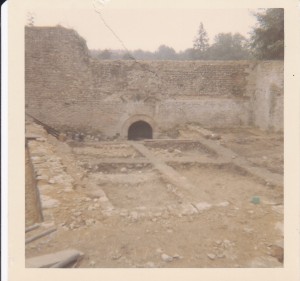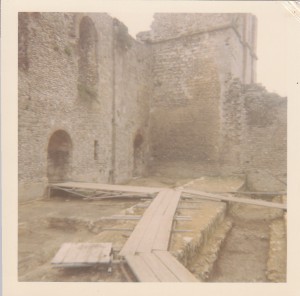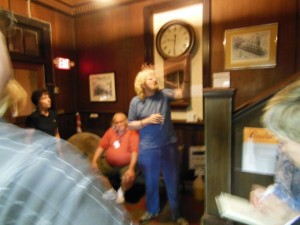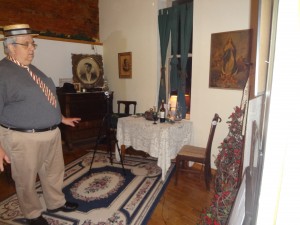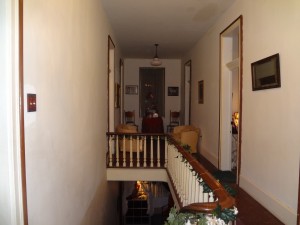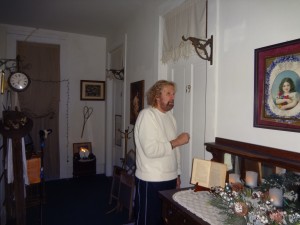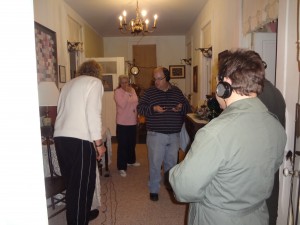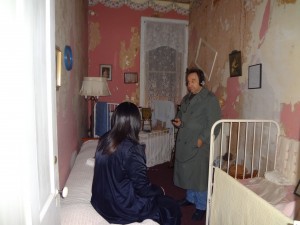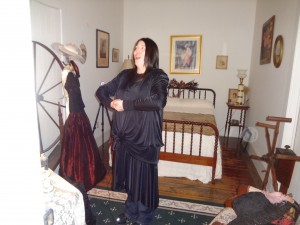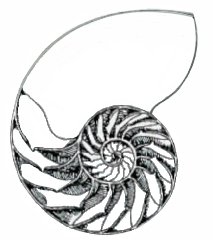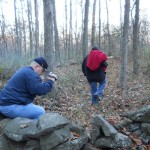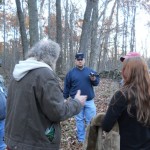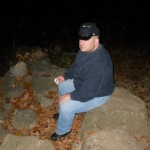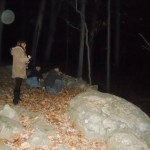The Origin of the Ghost Excavation Methodology
I work (have worked for more than four decades) among, and with, the remains of the “living dead”. I am not talking about two “recent” (yet old) motifs of contemporary popular culture, the “zombie” and the “vampire”. And the “material remains” that I “unearth” are no mere “walking dead”, the “ghosts” of archaeology. Many of these who remain are real spectral (and “live”) traces of human presence, “unearthed” during a “ghost excavation”.
The format of a “ghost excavation”, its storyboard, allows for the direct telling (and “voicing”) of individual, and personal, stories. These fragmented “stories” are important to the meaning of a “manifestation”, and serve as the primary means to interpret the archaeological remains that are “unearthed”. As a “haunting” version of “oral history”, these past remains can challenge the concept of linear histories, as a perception of a completed (and ended) past. This is an expanded approach to archaeological fieldwork that is not wholly dependent upon the physical presence of remains, but rather those “remains” that can be experienced in other sensory modalities, particularly the aural. This “aural sense” is an acoustemology ( a sonic sense) of understanding “what” and “who” remains from the past in particular spaces at a specific location.
A “ghost excavation” takes ghost research seriously as a subject of inquiry in its own right, and not as a metaphor (something that “haunts” us still), a conceptual devise (the “ghost” as something lost, forgotten, neglected), or a lucrative form of entertainment or personal gain (“ghost tourism”, ego-driven “ghost hunting”, or “paranormal reality TV programming”). But what is this “ghost excavation” methodology, and when was it “unearthed” as a legitimate form of social science investigative methodology?
The historical background of a “ghost excavation” is a story, like all archaeological stories, that works itself backwards to a past, one filled with recollections of highly personal and emotional fieldwork experiences. These experiences affected how I began to do research and how I perceive reality. The story begins as an “excavation” story that “digs” into the habitual and mundane (the true reality of an archaeological excavation) to finally expose and substantiate the authenticity of a different contemporary reality. This “different” contemporary reality is far more expansive (and human in nature) than what is thought of in general academic circles.
History
It began in the last year of the 6th decade of the 20th c., though it had its antecedents earlier in the previous decade (see my book, Ghost Excavator (2007).). Its true origin, however, began in the 10th century, was “dug out” in a 12th c. ruin, and entered contemporary reality based on 19th c. Victorian Spiritualism. All of this took place in Winchester, the ancient capital associated with Saxon kings, on an isle called England. It seems appropriate that it had its origin here as England has been called the most “haunted” country in the world. The methodology “manifested” during an archaeological excavation, but its haunting relevance was “born” in a 2nd floor apartment on the corner of High and St. Thomas streets during an enlightening seance.
The excavation story begins with Martin Biddle and the Winchester Excavation Committee at Winchester (1961-1971). The excavations in Winchester, six in number at the time of my participation, “represented a landmark in British archaeology in the 20th c.”, introducing into urban archaeology a multi-period, multi-disciplinary approach that became the methodology that was used at other sites throughout Europe and the world. Such an approach became an inspiration and model for the perspective (which includes archaeology, ethnography, performance and sound studies) and methodology (multiple strata of “intellectual uncertainty”) that I use at “haunted” locations during a “ghost excavation”.
Winchester was (is) well-noted for its “ghosts”, many of which inhabit the local pubs (such as the Hyde Tavern and the Eclipse Inn) along with other “spirits”. Winchester Cathedral is a known “haunt”, and the Winchester Cathedral “Close” (where I lived nearby in 1969) is noted for its various apparitions, the most famous being a “limping monk”. The history of hauntings at Winchester goes back centuries. There are stories of funeral processions of ghostly monks dating back to about 1640, and are described as “chanting monks, clanging hand bells, and flapping sacred banners” walk the streets, in burial procession, toward the cemetery.
My “excavation story” was “unearthed” at Wolvesey Palace, a place I came to know intimately for four weeks during that summer of 1969. It was my “Woodstock experience”! I was assigned the task of excavating what became the earliest known water piped system in English history (at that time). This lead-piped water system of the palace complex belonged to the early 12th c. During my time at Wolvesey, I also excavated earlier layers of a Roman occupation. Digging into Roman and Medieval History at Wolvesey, and contemporary reality on the corner of High and St. Thomas Streets, led me back to the past and the “haunting”!
The Ghost Story
“My Ghost Story” began on St. Catherine’s Hill, overlooking the city and the River Itchen. I had come to view (during a day off from the excavation), at the top of the hill, the circular Iron Age fort, built in 150 b.c. As I descended the hill, I explored the “mismaze” there, a series of nine rounded-edge squares cut sometime during the Medieval Period. There, I happened upon (by chance- ?) a local practioneer of Wicca, the ancient earth-based religion. The city of Winchester and the area around St. Catherine’s hill (in particular) are associated with witchcraft and the ancient arts. In 1440, people were “tried” by the ecclesiastical court for necromancy and sorcery here, and in 1667, a school mistress and her son were accused of witchcraft. The top of St. Catherine’s Hill was an ancient beech grove, and was the site of shamanistic chants and drumming. There is also a local legend which says that the hill was the eye of a pagan dragon.
This particular “wiccan” practioneer, appropriately dressed in black and purple, and looking like what was to be later called the “Gothic” look, had heard that I was interested in local ghost lore. She suggested that we return to her apartment (saying it was “haunted”) and have a séance. I agreed and we, along with three other companions, walked toward her apartment on the corner of High and St. Thomas Streets. We traversed the Winchester Cathedral Close, but did not see or sense the “limping monk”. We also passed through the Royal Oak Passage, before exiting onto High Street toward her apartment. We also did not encounter the “ghostly monk” said to “haunt” the Royal Oak Passage. The night was still young, so I was still “open” to experience something. Little did I know what was to transpire in that small apartment………!
The “Original” Ghost Story
This began, as a resonating factor in a future haunting, long before I worked at Winchester in 1969, and centuries before “England” was recognized as a country! Wolvesey Palace earned its name, so it is recorded in many accounts, after the story of a Saxon king, Egbert (827-828) who demanded to be paid each year with the heads of 300 wolves from the Welsh (G.I. Parkyns 1816:95 in Monastic and Baronial Remains: With Other Interesting Fragments of Antiquity in England, Wales, and Scotland. Some say Wolvesey means “Wolf’s or Ulf’s Ey (Island)”. This tribute in wolf heads is also recounted in the following passage:
“He took great pains in hunting and pursuing these ravenous animals; and when he found that all that escaped him had taken shelter in the mountains and forests of Wales, he changed the tribute of money imposed on the Welsh princes by Athelstan….into an annual tribute of three hundred heads of wolves….” (Chron. Sax. P. 116; H. Hunting Lib. 5 p. 356; Brompton, p. 865; W. Malmes Lib. 2, cap. 8).
There are still other accounts:
“The earliest history of Winchester is that Kinegils, soon after his conversion in 635, built a palace there, which Kenewahl, his son, gave to Saint Birinus for his residence, and that of succeeding bishops. After this, nothing seems to be known, except the payment of the tribute of the wolves heads….” (The Gentlemen’s Magazine, Vol. 171 (1842), p. 536).
A Dr. Milner, in his History of Winchester, wrote:
“Wolvesey is stated to have derived its name from the tribute of wolves heads imposed on the Welsh by King Edgar; and which it is asserted was ordered to be paid here” (The Gentlemen’s Magazine. Feb. 1829, p. 105).
Wolves were also the subject of “hunts”. Various Norman kings (1066-1152) employed servants as “wolf hunters” which eventually lead to the extinction of the wolf in the British Isles by the time of Henry VII (1485-1509). At the time of my archaeological work at Wolvesey, I did not know this history of Wolvesey, and its relation to wolves. This “unknown history” and relation between wolves and Wolvesey became the “haunting” that followed me one summer night in August, 1969 in a small apartment on High and St.Thomas Streets…..
The Haunting
During that séance, I became “possessed” by the “spirit” of a wolf. For a complete description of this “haunting experience”, please refer to my book, Digging Deep: An Archaeologist Unearths a Haunted Life (2009). The full story is described on pages 60-77. Based on this experience, a symmetry of certain “haunting” questions lingered in my mind for a long time: Did I become “haunted” by a wolf because I worked at Wolvesey, digging up the past? Did I become “possessed” by a wolf because its “ghost” still “haunts” the countryside around Winchester, where it was exhibited as a “trophy” in the form of tribute? Wolvesey Palace is in ruins, and the wolf is extinct in England. What lasts in the memory of that night are what became for me the methodology of a “ghost excavation”. And there is still the possibility of a wolf “possession” or “transformation”. Paul Devereux, in his book, Haunted Land (2001), reported an incident witnessed by a Professor Brian Bates of Sussex University. In “full waking consciousness” (as I was in that apartment) in an Austrian forest, the professor “saw a female ritualist’s head flickingly transform into that of a wolf (2001:161). Did my transformation only occur in my mind, or was it real? That question still “haunts” me! And it is why I continue to explore, after more than four decades, the possibilities of “ghostly” presences at “haunted” locations!
The Methodology
Winchester was (and remains) a city where multiple past presences continue to be experienced, in an archaeological way, as surface assemblages clearly visible to the eye and ear. Yet, beneath the surface, there remain other layers that remain hidden. Sometimes, quite unexpectedly, they become “unearthed” through resonating connections. This lesson was not ‘lost in the translation” of time from past to present, and present to future. It stabilized as a lasting memory of an encounter with a “ghost” from ancient English history and Winchester’s “haunted” past.
Working in the “gardens” at Wolvesey Palace during the day, and investigating what still “haunts” (and manifests) the present at night, has allowed me access to a connecting field – resonating in nature – that linked present to past, the living and the dead. It provided, and still does, a framework in which to expand the “field” of normal reality. In this reality, meaning in the Winchester “digs” (both archaeological and “ghostly”) was created through personal “still points”: Wolvesey and wolves; archaeology and field performance practices as “P.O.P.”; and resonating field practices that expanded the concept of “ordinary” reality as more than binary opposites: “living” and “dead”; past and present, etc. This extended reality became what is real back to what was “ordinary” not “paranormal”!
The anthropologist Gregory Bateson called this a personal map-making “ideation”. It is a way of imposing order on something once thought unexplainable. It is the recognition of a pattern, and looking for the means to make a connection. For me, this became the connection of a storyteller, an “excavation” story, and something more than a “ghost” story. In storytelling, an important archaeological characteristic in itself, it became the “ghost excavations” that I have been doing in the field all these decades. And that is why the “ghost excavation” attempts to recover this expanded reality, not a “paranormal event!
As Mary and I traveled to Winchester last year (before presenting a video on our “ghost excavations” at Burnside Bridge, Antietam Battlefield), I recalled how it all began, decades earlier. And it brought a tear to my eye as our train from London pulled into the Winchester station. It was my first journey back to Winchester since my fieldwork there in 1969. But the memory of “what happened there” remains actively present in my mind. It will never become just a “phantom” presence. It lingers to “haunt” me in each and every “ghost excavation” we do!
